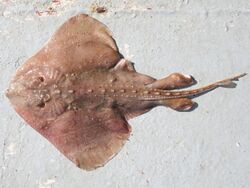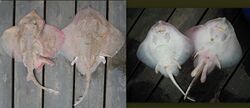Biology:Thorny skate
| Thorny skate | |
|---|---|

| |
| Scientific classification | |
| Domain: | Eukaryota |
| Kingdom: | Animalia |
| Phylum: | Chordata |
| Class: | Chondrichthyes |
| Subclass: | Elasmobranchii |
| Superorder: | Batoidea |
| Order: | Rajiformes |
| Family: | Rajidae |
| Genus: | Amblyraja |
| Species: | A. radiata
|
| Binomial name | |
| Amblyraja radiata (Donovan, 1808)
| |
| Synonyms | |
| |
The thorny skate (Amblyraja radiata) is a species of fish in the family Rajidae. This bottom-living skate lives in the North and south-eastern Atlantic Ocean in depths ranging from 20 to 1,000 m (66–3,281 ft) and water temperatures from −1 to 14 °C (30–57 °F).[1]
Species description
The thorny skate reaches up to 1.05 m (3.4 ft) in total length and 11.4 kg (25 lb) in weight.[1] Its underside is smooth, but the upper side, as the name suggests, is very rough with many small thorns all over and 13-17 larger ones in line from the back of the head to end of the tail. The top side is brown with possibly black spots and the underside is white. It has a hard, roughly triangular snout and a tail, which is shorter than its body. It eats crustaceans, small fishes, and worms. It produces egg capsules, which are 3.4-8.9 cm long and 2.3-6.8 cm wide, which hatch outside the body.
Conservation status
Thorny skate are taken as bycatch in some fisheries. It is a U.S. National Marine Fisheries Service species of concern, which are those species about which the U.S. National Oceanic and Atmospheric Administration, National Marine Fisheries Service, has some concerns regarding status and threats, but for which insufficient information is available to indicate a need to list the species under the U.S. Endangered Species Act.
References
- ↑ 1.0 1.1 Froese, Rainer and Pauly, Daniel, eds. (2017). "Amblyraja radiata" in FishBase. December 2017 version.
Kulka, D.W., Ellis, J., Anderson, B., Cotton, C.F., Derrick, D., Pacoureau, N. & Dulvy, N.K. 2020. Amblyraja radiata. The IUCN Red List of Threatened Species 2020: e.T161542A124503504. https://dx.doi.org/10.2305/IUCN.UK.2020-3.RLTS.T161542A124503504.en. Accessed on 20 March 2022.
External links
- Species Description of Amblyraja radiata at www.shark-references.com
- "Thorny Skate". Florida Museum. https://www.floridamuseum.ufl.edu/discover-fish/species-profiles/amblyraja-radiata/.
Wikidata ☰ Q599499 entry
 |



